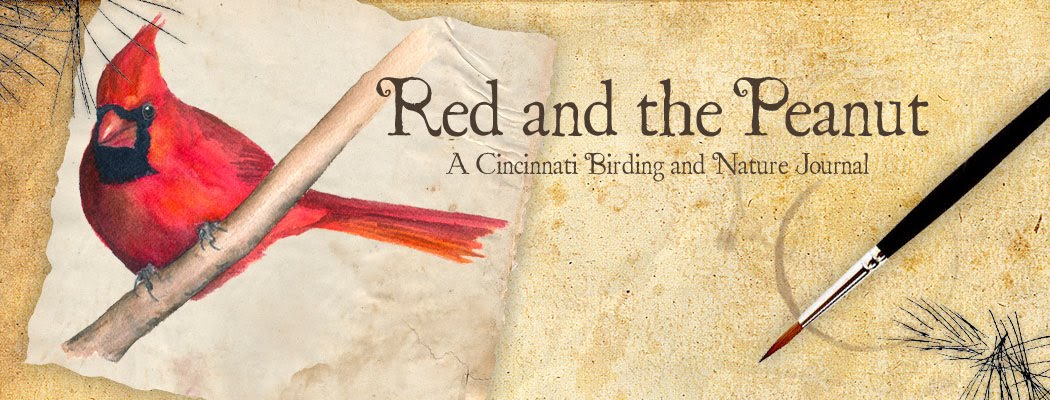For the first time ever, we had a Red Fox (
Vulpes vulpes) in our yard. A big thank you goes to my neighbor, Chet (13 years old and a
fellow snake lover), who spotted the young fox in the bushes near our kitchen window. Knowing I'd love to photograph the new visitor, Chet crept over to our front door to let me know. As soon as he told me, I grabbed the camera and headed for the back door. By then Little Red Fox had moved to the backyard, but I was still able to photograph him through our fence...
 |
| Little Red Fox dropped by this weekend and charmed us with his foxy wiles. |
I don't know a lot about foxes, so I had to get out my books and do a little online research to figure out exactly what kind of fox Little Red was and what he was doing in our side yard. I learned there are two species of foxes in Ohio, Red Foxes (
Vulpes vulpes) and Gray Foxes (
Urocyon cinereoargenteus). Red Foxes have reddish fur on their bodies with black on their legs. They have white muzzles, throats, and chests, and also a white tip on their tail. Basically, Red Foxes are the stereotypical fox we all know. Gray Foxes are much darker with gray fur on their bodies and reddish fur on their legs and faces. Their tails are tipped in black with a noticeable black stripe down the middle.
Red Foxes are often seen in urban and suburban environments, while Gray Foxes avoid human habitation and prefer deep woods. Because Red Foxes like the open fields and forest edges created by humans, they benefited when the European settlers cleared the Ohio forests for farmland in the 1700s. Until then, there were only Gray Foxes in Ohio. Red Foxes moved down from the north as their preferred habitat was created, while Gray Foxes retreated away from the settlements, and today they are found primarily in the deep woods of southeastern Ohio.
 |
| Before he ran off, Little Red stopped and looked back at Chet and me. We were standing on the deck, and he was definitely curious. We didn't move to come after him. We just watched him watching us. |
Red Foxes are not new to the suburbs of Cincinnati. For years, Rick, Matty and I have seen foxes making their nightly runs along nearby golf courses and forest edges, but we've never had one hide in the bushes outside our kitchen window. Turns out, Red Foxes have been moving steadily closer to humans as the coyote population expands. An article in
The Columbus Dispatch by Jim Weiker titled,
"Foxes seek refuge from coyotes in suburbs," explained a lot. For the past 20 years, the coyote population in Ohio has been on the rise. Coyotes hunt the same prey foxes do (e.g., mice, chipmunks, squirrels and rabbits). When prey is scarce, however, coyotes also hunt foxes and their kits. In the article, Suzanne Prange, a wildlife research biologist, hypothesizes that foxes seem to have figured out coyotes don't like humans, and therefore, their kits are safer near human developments.
 |
| Even though he was curious, after a few seconds "Stranger Danger " showed up in his expression, and Little Red headed off. |
In an article in the
New York Times titled
"Red Foxes Thriving in Suburban Woods," by William K. Stevens, I learned the Red Fox has become the most widely distributed wild carnivore on earth because it is able to adapt to the presence of humans and thrive in our man-made, chopped-up environments. Biologists believe foxes are here to stay because of their "super-adapter" status.
 |
| Run Little Red, run...run like the wind! |
When I was watching Little Red, I was surprised at how cat-like he was. Foxes are in the same biological family as dogs, Canidae, but Little Red had so many feline characteristics it made me do a double-take. His whiskers on his face were really long, and watching him slink through the grass as he left our yard brought the image of a cat to mind...not a dog. In the New York Times article, Stevens mentions a book written by a Canadian ecologist named Dr. J. David Henry called "Red Fox: The Catlike Canine." I was happy to see that. I need to get that book to read more about their feline ways! Henry confirmed several catlike adaptations, including the fact that foxes, which are primarily nocturnal, have pupils that close to vertical slits in bright light like cats' pupils do to help prevent blinding.
 |
| Red Foxes can sprint up to 45 mph for a short distance, and they run in a straight line. They have small stomachs, which keep them light on their feet. Because of that, they can't gorge like coyotes. Instead, they eat their fill and hide the rest until they are hungry again. |
 |
| I hope you come back, Little Red! |
So it seems we all have been sharing our suburban yards with Red Foxes for a quite a while, but they go unnoticed mainly because they are secretive and nocturnal. Red Foxes, however, will hunt during the day, and if they are disturbed in their hiding places, they will run too. So if you see a Red Fox during the day, don't assume he is sick. He probably isn't. Autumn is when young foxes leave their parents, setting off to find their own territory, so our Little Red was probably doing just that. Young foxes are even more likely to run during the day. Our yard had an overabundance of rabbits this year. I left a large part of the backyard go wild this summer, hoping to attract more birds by creating a tiny prairie with lots of grasses and wildflowers. Perhaps this helped create an ideal nursery for bunnies, and maybe the foxy Little Red was drawn to the ready supply of food, running water, and large bushes for shelter. Who knows...but from what I read, I bet we will see him again.
Resources:
The Ohio Department of Natural Resources (ODNR), Division of Wildlife:
- for Red Fox information,
click here. and click here.
- for Gray Fox information,
click here.
Click here for the New York Times article written by William K. Stevens titled
"Red Foxes Thriving in Suburban Woods."
Click here for the Columbus Dispatch article written by Jim Weiker titled
"Foxes seek refuge from coyotes in suburbs." (There is a cute video with this article showing a Red Fox family playing in a suburban backyard.)
Click here for another article titled
"Red Foxes are on the Rise in Suburban and Urban Areas" by the Brandywine Conservancy's Environmental Management Center.















